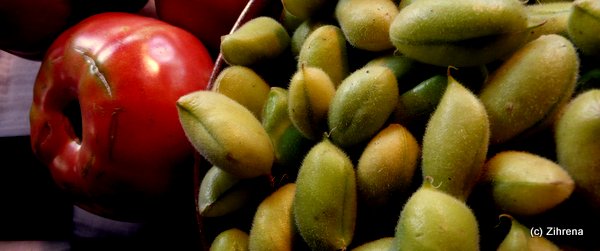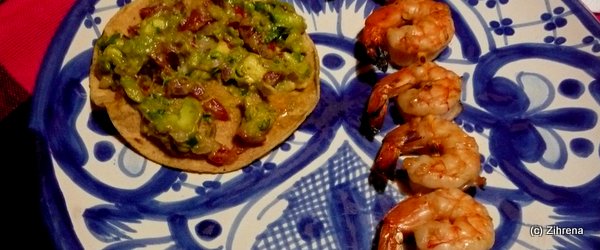The typical dishes of the state of Guerrero, Mexico, center unsurprisingly around the regional agricultural staples: corn, beans, tomatoes, squash, and chiles. Indigenous animals that were used for food before the arrival of the Europeans, some of which are still common in the local cuisine today, include wild turkeys, armadillos, lizards, deer, rabbits and other rodents, and a number of insects. In coastal areas, fish and seafood naturally prevail.
Over the course of Mexican history, with the ebb and flow of the Spanish, French, and traders from the Philippines and the Far East during the crossings of the Nao de China (the Manila Galleon), many new products were introduced into the Americas and gained favor with the locals. Beef, pork, chicken, and the resulting dairy products were introduced by the Spanish; soufflés, pastries, and bread products were brought by the French; and rice, which is widely served with both coastal and inland dishes, came from the Orient. Corn, however, in the guise of tortillas, hominy, and other corn products, continues to be the preferred starch, particularly in rural areas.
Note: Although I follow a plant-based diet and encourage others to do the same, this article of necessity contains references to animal products that traditionally have been used–and still are being used–in the cuisine of the state of Guerrero, Mexico. Many of these dishes can be adapted to plant-based versions and still retain their savory and traditional flavors, and our local Zihuatanejo Cooperativa Eco-Vegana is doing a great job of doing just that. Take a moment to visit the co-op’s website, support their efforts, and consider transitioning to a plant-based or largely plant-based diet for your own health.
In many parts of Guerrero, Thursdays are pozole days. Pozole is hominy corn (white maize treated with lime) in a broth of pork (often pig’s feet) and chicken, garnished at the table with chopped onion, oregano, chile verde, chile piquin, radishes, pork rinds, limes, and sometimes avocado and ranch-style fresh cheeses. The hearty soup comes with either a light-colored broth (pozole blanco, with pork) or a green broth (pozole verde–with chicken–containing tomatillos, sometimes pumpkin seeds, green chiles, cilantro). In some areas of the state, a seasonal fresh corn pozole, called elepozole or elopozole, is common. Its ingredients include tender corn grains freshly scraped from the cob, chicken, pork, small zucchini squash (calabacitas), fresh green beans, chile guajillo, and seasonings: salt, pepper, garlic, onion, and epazote. Pozole is a meal in itself.

For a month or two during the winter season, fresh garbanzo beans in the pod (pictured above) can be found in our local Zihuatanejo market. These are brought down from the hills of the state and are very similar in taste and texture to edamame soybeans. Parboil or steam them in their shells for 5 or 6 minutes or roast them on a hot griddle or cast-iron frying pan. Toss with coarse sea salt, if desired, and squeeze the tender beans out of the shells into your mouth in the same way as you would edamame beans.
As in other parts of Mexico, mole plays an important role in the regional cooking of Guerrero state. Moles are rich and thick sauces, sometimes dark chocolate brown, other times deep red, and yet other times, rich green. They are concocted of dried chiles of every variety–guajillo, mulato, pasilla, ancho–as well as such varied ingredients as pumpkin seeds, cacao, ground peanuts, sesame seeds, raisins, red and green tomatoes, garlic, and onion. These incredible mixtures are seasoned yet further with herbs and spices ranging from salt, pepper, and oregano to cinnamon, cloves, annatto seeds, and epazote. The sauces are thickened by adding masa harina, cornflour dough used for tortillas and other regional corn-based dishes. Traditionally, moles are cooked and served with chicken, pork, and other meats. The indigenous names for the various types of moles or sauces evoke visions of ancient days: chilmole, ayomole, clemole, huaxmole.
Atoles—hot, sweetened, drinks flavored with fruits or spices such as cinnamon–are also thickened with corn flour (or, nowadays, just corn starch). Atoles warm ones bones on chilly mountain mornings and traditionally are served on holidays and special occasions such as on Three Kings Day (January 6) and at the graveyard on the Day of the Dead, or All Soul’s Day (November 1).
In the state of Guerrero, the town of Chilapa, near the state capital of Chilpancingo, is known for its French cuisine, a heritage from the Sisters of the Incarnate Word who taught students from the region in their college during the nineteenth century. The people of Olinalá, from whence come lovely hand-lacquered gourds and boxes made of delicately scented linaloé wood, prepare a traditional red mole, and the town is also known for its underground barbecued goat.
One of the specialties of Taxco, a colonial silver mining center in the interior highlands of Guerrero, is mole de jumil. The jumil is a variety of highly nutritious stink bug that can be eaten roasted, fried, ground, or raw. (See Wikipedia contributors, “Jumiles,” Wikipedia, The Free Encyclopedia, http://en.wikipedia.org/w/index.php?title=Jumiles&oldid=592348756 [accessed April 16, 2014].) In the more remote, poorer areas of Mexico, insects are important sources of protein for the local populations; the jumil is just one variety of insect popular in Mexican gastronomy.

Iguala is known for its adobo de cochinita (suckling pork in adobo sauce). Teleloapan boasts of its chalupas (flat-fried tortillas) mounded with slivered meat, onion, and chipotle chile sauce. In Tierra Caliente, aporreadillo makes its mark: a toss of cecina (salted and dried beef), eggs, and chile sauce.
On the coast, Acapulco serves pulpo enamorado, tender octopus cooked with tomatoes, chiles, and sometimes onion, served with mayonnaise, and Acapulco-style ceviche. Methods of preparing pescado a la talla–whole, flattened fish smothered in savory sauce and grilled–shine in both the Costa Chica south of Acapulco and the Costa Grande, which runs from Acapulco north to and beyond Zihuatanejo. In addition, Zihuatanejo is proud of its regional tiritas de pescado, marinated fish strips served with chopped chiles, sliced onion, and sliced cucumber.
Throughout the state of Guerrero, handcrafted, regional desserts and sweets are to be found: tangy tamarind pulp sweetened and mixed with salt and hot chile is a favorite, and cocadas, coconut candies, are found up and down the Pacific coast. On the Costa Grande, empanadas de coco or camote–rustic hand-shaped bread pockets stuffed with sweet coconut or sweet potato pastes–are sold in villages along the highway.
Sources and resources:
“Guerrero, Bella Tierra Tropical,” MexicoProduce.mx, http://www.mexicoproduce.mx/destinos/guerrero.html
“Gastronomía,” Portal Oficial del Gobierno del Estado de Guerrero, http://guerrero.gob.mx/articulos/gastronomia/
“Linalóe,” Enciclopediagro.org, http://www.enciclopediagro.org/index.php/indices/indice-flora-y-fauna/944-linaloe
Wikipedia contributors, “List of food origins,” Wikipedia, The Free Encyclopedia, http://en.wikipedia.org/w/index.php?title=List_of_food_origins&oldid=602573507 (accessed April 17, 2014).
“The French Influence On Mexican Cooking: La Comida Afrancescada,” Mexconnect, http://www.mexconnect.com/articles/2139-the-french-influence-on-mexican-cooking-la-comida-afrancescada
Wikipedia contributors, “Manila galleon,” Wikipedia, The Free Encyclopedia, http://en.wikipedia.org/w/index.php?title=Manila_galleon&oldid=601379813 (accessed April 17, 2014).